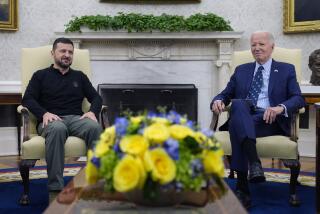Battle breaks out over the Predator
WASHINGTON — Defense Secretary Robert M. Gates has ordered the Air Force to put nearly all of its unmanned Predator aircraft into the skies over the Middle East, forcing the service to take steps that officers worry could hobble already-stressed drone squadrons.
Pressure from the Defense secretary in recent months has nearly doubled the number of Predators available to help hunt insurgents and find roadside bombs in Iraq. But it has forced air commanders into a scramble for crews that officers said could hurt morale and harm the long-term viability of the Predator program.
Some officers said pressure from Gates resulted in one plan that could have taken the Air Force down a path similar to the German Luftwaffe, which cut back training in World War II to get more pilots in the air.
“That was the end of their air force,” said Col. Chris Chambliss, commander of the Air Force’s Predator wing. The Air Force plan, presented to the military leadership in January, eventually was scaled back.
The surge in drone flights is Gates’ latest push for short-term measures to win the Iraq war that will have long-term implications for the U.S. military. In recent months, Gates has campaigned to increase the size of the Army and to ship new, heavily armored troop transporters, known as MRAPs, to Iraq.
Because of the far-reaching implications of the Predator debate, a fight has broken out between the Army and the Air Force over control of one of the most heralded technological successes of the war.
The Army has argued that more overhead drones will save troops’ lives, a position largely adopted by Gates. But the Air Force has complained that simply demanding more, with no end in sight, would severely strain the service -- just as repeated deployments of ground soldiers has strained the Army.
“The leadership has to be careful,” said one senior Air Force official who, like several others, spoke on condition of anonymity when describing internal debates. “If you keep on pushing them and pushing them and pushing them, and they say, ‘Yes, yes, yes, yes,’ at some point, they’re going to break. Because they ain’t going to say no until they break. No one wants to say ‘uncle.’ ”
Gates set up a team within his office to examine ways to increase Predator flights last year, when 12 were continuously flying combat patrols. Now there are 22, and Gates is pressing for more.
His push to expand the use of drones grew out of a conviction last year that many agencies within the Pentagon were not at full war footing. By then, Gates already had taken aim at a pair of high-profile problems: failures that led to the Walter Reed Army Medical Center scandal, and MRAPs.
In an interview this year, Gates said the lack of spy planes -- known as intelligence, surveillance and reconnaissance, or ISR aircraft -- was his third major gripe with the military leadership he inherited.
“In ISR, it was business as usual,” Gates said. “I really pushed the Army and the Air Force -- particularly the Air Force -- and I intend to keep pushing because the unmet need is huge.”
In response, the Air Force has stepped up training. Next year, commanders will train 200 two-man crews to remotely fly a fleet of Predators that numbers more than 100, as well as a larger version called the Reaper, mostly out of a spartan air base in the Nevada desert. Trainers will turn out more pilots for Predators next year than for all other Air Force fighter planes combined.
But in the most dramatic example of brinkmanship in the struggle, the plan debated by the military leadership in January would have shut down the Predator training operation in order to increase to 36 the number of Predators continuously flying combat patrols in the Middle East by August.
The plan was dubbed “all in” by its developer, Gen. T. Michael Moseley, the Air Force chief of staff.
Although the most drastic parts of Moseley’s “all in” plan have not been carried out, the Predator program has been forced through three makeovers since July, and the service has had to take aggressive steps to meet the new demand.
At first, the Air Force extended the tours of the Predator crews. By September, however, officials began to recall many of the pilots who had completed their Predator duty and left for fighter and bomber assignments elsewhere.
Then, as part of the January deal, Predator and Reaper crews were frozen. Even pilots who have been flying drones nonstop for three years will have to remain in Nevada for at least two more years. Many of them originally were trained as fighter and bomber pilots.
Air Force officials are acutely aware that their concerns may seem like whining, particularly compared with Army counterparts who serve 15-month tours in Iraq and Afghanistan. Still, Predator crews have been working 13-hour days, sometimes six days a week, for three years with no end in sight.
“Now we’re saying: ‘Hey, you guys are just going to be here until we stop,’ ” said Chambliss, the Predator wing commander, comparing the tours of duty to “a prisoner with a finite term versus a prisoner with a life sentence.”
In the debate over control of the fast-growing fleet, the Air Force argues that only qualified pilots should fly airplanes that drop bombs and fire missiles. But Army ground commanders maintain they most need and use the streaming video to plan and execute their ground operations.
“I want to control it,” said Lt. Col. Adam R. Hinsdale, head of the Army’s unmanned aircraft program, which has its own family of smaller, short-range drones. Hinsdale said Army troops occasionally found that an Air Force Predator assigned to their unit had unknowingly flown off for other missions. “I don’t want it to be pulled away.”
Moseley, the Air Force chief of staff, acknowledged the risks of overstretching Predator crews during an interview last month aboard his plane returning from Nellis Air Force Base in Nevada.
He insisted his January plan was not an attempt to fire a warning shot at the Pentagon leadership. As a former war commander -- he ran the air war during the Iraq invasion -- Moseley said he understood the importance of supplying commanders in Iraq with the aircraft they needed.
“This is a good thing and it’s operationally useful, so you can see where people want more of it,” Moseley said.
Others saw Moseley’s plan as an attempt to highlight the potential for long-term damage to the Predator program.
“We’ve already pushed pretty hard,” the senior Air Force official said. “At that point, the chief goes, ‘OK, they want more, here’s what we’re going to do: Shut down the schoolhouse, shut down test and training . . . chain the operators to the consoles, give them a coffee can to pee in.’ ”
But Pentagon officials familiar with Gates’ thinking said he was not likely to let up. As one example, the Air Force is under pressure to give up its insistence that only qualified pilots fly Predators. That would significantly expand the available pool of operators.
“I’m not satisfied that anybody in the Pentagon is doing enough to put us on a path where we have adequate resources for this,” Gates said in the interview this year.
--
More to Read
Sign up for Essential California
The most important California stories and recommendations in your inbox every morning.
You may occasionally receive promotional content from the Los Angeles Times.










